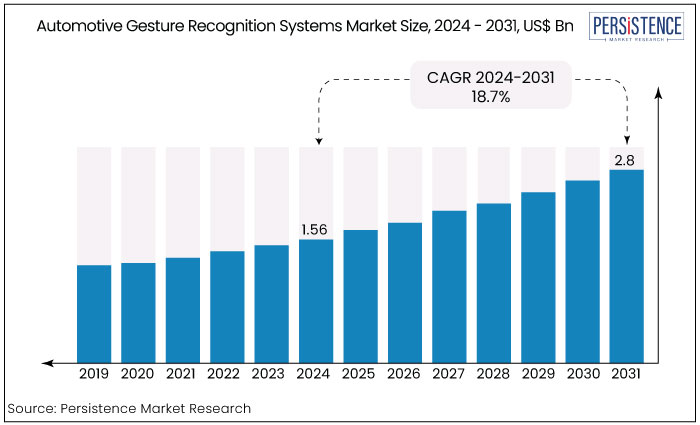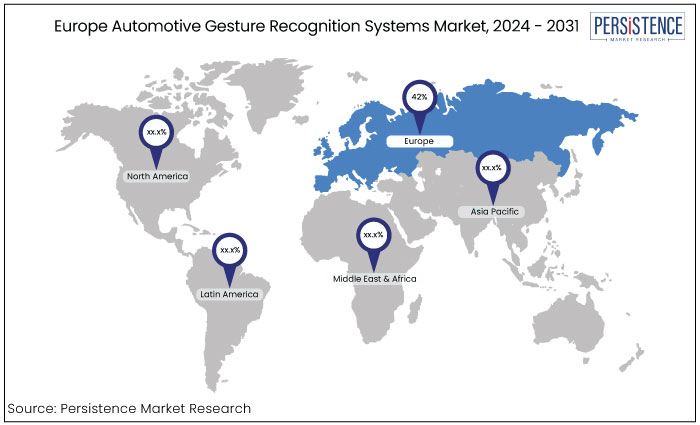Automotive Gesture Recognition Systems Market
Industry: Automotive & Transportation
Published Date: October-2024
Format: PPT*, PDF, EXCEL
Delivery Timelines: Contact Sales
Number of Pages: 170
Report ID: PMRREP34864
The automotive gesture recognition market is estimated to increase from US$1.56 Bn in 2024 to US$2.8 Bn by 2031. The market is projected to record a remarkable CAGR of 18.7% during the forecast period from 2024 to 2031. The market growth is attributed to the increasing demand for intuitive, and user-friendly interfaces driven by consumer expectations for advanced technology, and the rise of autonomous vehicles.

Key Highlights of the Market
|
Market Attributes |
Key Insights |
|
Market Size (2024E) |
US$1.56 Bn |
|
Projected Market Value (2031F) |
US$2.8 Bn |
|
Global Market Growth Rate (CAGR 2024 to 2031) |
18.7% |
|
Historical Market Growth Rate (CAGR 2019 to 2023) |
14.5% |
|
Region |
Market Share in 2024 |
|
Europe |
42% |
Europe is expected to command a notable automotive gesture recognition market share of over 42% in 2024 with Germany emerging as a leading player. The rapid advancements in technology and its stringent safety regulations create an environment conducive to market growth. Germany is at the forefront of developing innovative gesture recognition systems, which significantly contribute to the overall expansion of the sectors.
Strict safety standards set by both German authorities and the European Union promote the widespread adoption of advanced driver-assistance systems including gesture recognition technologies. These regulations compel automotive manufacturers to incorporate state-of-the-art safety features ensuring that vehicles comply with rigorous standards. Germany's commitment to enhancing road safety driving market growth.

Asia Pacific market is projected to experience significant growth in the next four years driven by several key factors. The region is witnessing a surge in automotive production, with manufacturers ramping up output to meet rising consumer demands. This increase is further fueled by a growing preference for luxury vehicles, which often incorporate advanced technologies, including gesture recognition systems.
The enforcement of stringent regulations aimed at enhancing road and driver safety is playing a crucial role in shaping the market landscape. These regulations not only encourage the adoption of innovative safety features but also create a favorable environment for the development and implementation of gesture recognition technologies offering lucrative opportunities for industry stakeholders.
In 2022, the hand/fingerprint/palm/leg segment of the automotive gesture recognition market accounted for significant revenue share. This growth is propelled by advancements in automotive technology particularly through patented innovations.
A notable example is a patent from Huawei unveiled in August 2023, which introduces a groundbreaking car technology utilizing gestures made on the steering wheel referred to as car steering gestures. When a driver executes a specific gesture on the wheel, the system recognizes it and activates relevant control functions based on hand positioning.
Innovations in gesture recognition systems enable vehicles to respond to various gestures, hand movements, and biometric data, including fingerprints and palm scans thereby transforming user interaction and enhancing safety and convenience for drivers and passengers.
|
Category |
Market Share in 2024 |
|
Application - Multimedia/Infotainment/Navigation |
59.6% |
The multimedia, infotainment, and navigation segment is projected to account for 59.6% of the automotive gesture recognition market share in 2024. The integration of hand gesture technology into smart display systems is a key factor fueling this growth. This innovative approach allows drivers to control multimedia, infotainment, and navigation features through simple, intuitive hand gestures thereby significantly enhancing safety by reducing distractions while driving.
A notable example is Hyundai Mobis Company's groundbreaking launch in November 2022 of its hand gesture recognition technology known as Quick Menu Selection. This pioneering feature introduced the world's first proximity detection pop-up display enabling users to effortlessly access frequently used menus by merely moving their hands near the display. Consequently, improving user interaction and convenience in vehicles.
Automotive gesture recognition systems refer to advanced technology that enables drivers and passengers to control various vehicle functions through hand gestures enhancing the user experience and promoting safety. These systems utilize sensors, cameras, and sophisticated algorithms to detect and interpret gestures, allowing users to adjust the navigation system, control music, or answer phone calls without physical contact.
Gesture recognition serves as a hands-free interface that minimizes distractions, improving focus on driving as vehicles become increasingly integrated with smart technologies. The growing demand for enhanced user interfaces and the proliferation of connected vehicles are driving the adoption of this innovative technology in the automotive sector.
The industry is witnessing significant growth driven by several automotive gesture recognition systems market trends. One of which is advancements in artificial intelligence and machine learning. Increasing consumer demand for intuitive user interfaces is pushing manufacturers to integrate gesture recognition capabilities into new vehicle models.
The rise of electric and autonomous vehicles is creating fresh avenue for innovation in gesture-based controls. Enhanced safety features and regulatory compliance concerning driver distraction are also propelling market growth. Moreover, partnerships between automotive manufacturers and tech companies are fostering the development of promising future for gesture recognition in the automotive industry.
The automotive gesture recognition systems market has experienced significant CAGR of 14.5% during the period from 2019 to 2023. This growth can be attributed to the increasing demand for user-friendly interfaces in vehicles driven by technological advancements in sensor and camera capabilities.
As consumers seek enhanced convenience and safety features, manufacturers have increasingly integrated gesture recognition systems into their designs resulting in a surge in adoption. The market is projected to accelerate further with an expected CAGR of 18.7% during the period from 2024 to 2031. This anticipated growth is fueled by the ongoing evolution of connected and autonomous vehicles, where gesture recognition will play a crucial role in creating seamless human-vehicle interactions.
The focus on reducing driver distractions and improving the overall user experience will drive investments and automotive gesture recognition systems market opportunities. As automotive manufacturers collaborate with tech companies to innovate and refine these systems, the industry is poised for significant expansion.
Increasing Demand for Enhanced User Interfaces
The automotive industry is shifting toward intuitive and user-friendly interfaces driven by consumer expectations for advanced technology in their vehicles. Gesture recognition systems facilitate hands-free operation allowing drivers to control navigation, music, and communication systems without diverting their attention from the road. This capability enhances user experience and promotes safety by minimizing distractions.
Consumers increasingly expect similar functionalities in their vehicles as they become familiar with gesture-based controls in other tech domains such as smartphones and smart home devices. The rising trend of integrating connected technologies into vehicles further amplifies automotive gesture recognition systems demand making them a vital feature for modern automotive designs.
Advancements in Sensor and Camera Technologies
Technological advancements in sensors and camera systems have notably contributed to the automotive gesture recognition systems market expansion. Modern vehicles are equipped with sophisticated sensors that can accurately detect and interpret hand movements even in varied lighting conditions and from different angles.
Enhanced camera technologies including 3D imaging and depth sensing enable these systems to function with high precision making gesture recognition more reliable and effective. As these technologies continue to evolve, they allow for greater integration of gesture recognition capabilities into vehicles. This expands the range of possible applications and improves overall system performance encouraging automotive manufacturers to adopt these technologies for a competitive edge in the market.
Growth of Autonomous Vehicles Remains a Primary Driver
The rise of autonomous vehicles is a key driver for the market growth. As vehicles increasingly automate driving functions, the need for advanced user interaction methods becomes paramount.
Gesture recognition offers a natural and intuitive way for passengers to interact with the vehicle's systems. This allows them to control entertainment, navigation, and other features effortlessly.
Gesture-based interactions can enhance the user experience in a fully autonomous environment by providing a seamless connection between passengers and the vehicle. As the development of autonomous vehicles accelerates, automotive manufactures are likely to invest more in gesture recognition technologies positioning them as essential components in the future of transportation.
Technical Limitations and Reliability Concerns
Technical limitations and reliability concerns also pose challenges to the automotive gesture recognition systems market revenue. While gesture recognition technology has advanced, it can still struggle with accuracy in various environmental conditions such as poor lighting or obstructed views.
Inconsistent performance can lead to user frustration and decreased trust in the system, which may hinder widespread adoption. The complexity of accurately interpreting gestures can result in miscommunication between the user and the vehicle increasing safety concerns.
High Development Costs
One of the significant factors impeding automotive gesture recognition systems market growth is the high development and implementation costs associated with these technologies.
Integrating advanced gesture recognition systems requires substantial investment in research and development as well as in sophisticated hardware and software. This financial burden can deter smaller automotive manufacturers from adopting such technologies, limiting market expansion. Additionally, the costs associated with ongoing maintenance and updates can further strain budgets.
Integration with Augmented and Virtual Reality
The integration of automotive gesture recognition systems with augmented reality (AR) and virtual reality (VR) presents a significant future opportunity.
As automotive technology evolves, incorporating AR and VR can enhance the overall driving experience by providing immersive interfaces for navigation, entertainment, and vehicle diagnostics. For instance, gesture recognition can enable drivers to interact with holographic displays projected onto the windshield allowing for intuitive control of various vehicle functions while keeping their focus on the road. This synergy can not only improve user engagement but also drive innovation in vehicle design, creating a connected and interactive driving environment.
As AR and VR technologies continue to advance, their collaboration with gesture recognition systems will open new avenues for automotive applications.
Rise in Electric and Autonomous Vehicle Markets
The growing electric and autonomous vehicle markets present a promising opportunity for the automotive gesture recognition systems market concentration. As these vehicles evolve, manufacturers are increasingly focused on enhancing user experience through innovative control systems.
Gesture recognition can serve as a natural interface enabling passengers to manage in-car features effortlessly without needing physical buttons or screens. This aligns with the autonomous vehicle experience, where traditional controls may become less relevant.
Electric vehicles often emphasize tech-driven features, making gesture recognition an attractive selling point. As consumer interest in electric and autonomous vehicles continues to rise, there will be greater demand for sophisticated gesture recognition systems, driving market expansion and technological advancements in this domain.
The market is a dynamic and competitive landscape characterized by rapid innovation and collaboration among key players. For instance, Continental AG has made significant strides with its "Gesture Control System," launched in 2022, which utilizes advanced camera and sensor technologies to enhance user interaction in vehicles.
Companies like Continental AG constantly focus on improving accuracy and reliability while exploring partnerships with tech firms to integrate artificial intelligence, further driving the evolution of gesture recognition systems in the automotive sector.
Recent Developments in the Automotive Gesture Recognition Systems Market
|
Attributes |
Details |
|
Forecast Period |
2024 to 2031 |
|
Historical Data Available for |
2019 to 2023 |
|
Market Analysis |
US$ Billion for Value |
|
Key Regions Covered |
|
|
Key Market Segments Covered |
|
|
Key Companies Profiled |
|
|
Report Coverage |
|
|
Customization & Pricing |
Available upon request |
By Authentication
By Application
By Region
To know more about delivery timeline for this report Contact Sales

The market is estimated to increase from US$1.56 Bn in 2024 to US$2.8 Bn by 2031.
Some of the leading industry players in the market are Apple Inc., Cognitec Systems GmbH, and Continental AGs.
The multimedia, infotainment, and navigation segment is projected to account for 59.6% of the market share in 2024.
Europe is projected to dominate the market with over 42% with Germany leading the way.
A key opportunity lies in the rise of electric and autonomous vehicles.